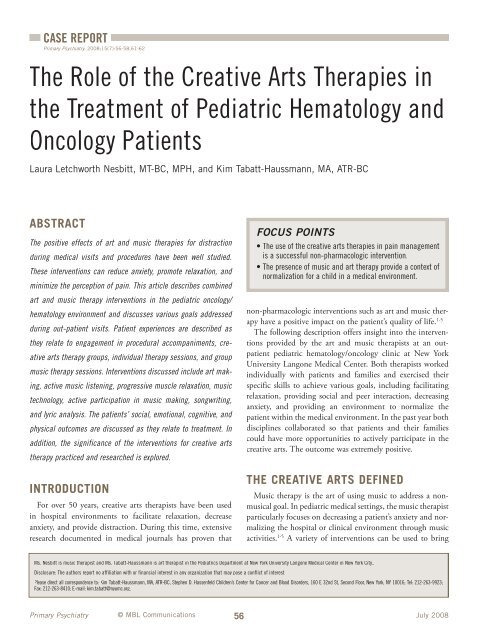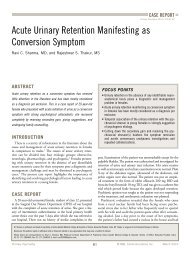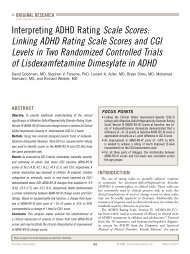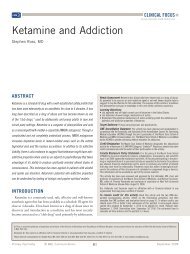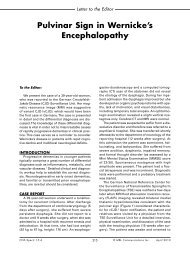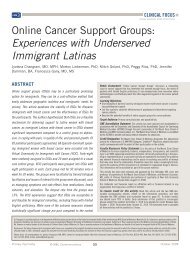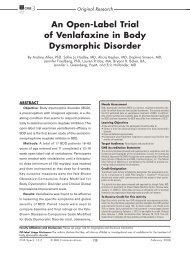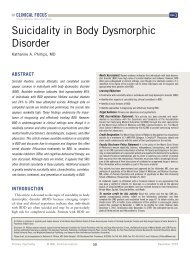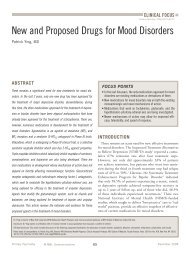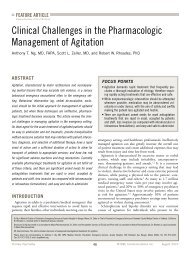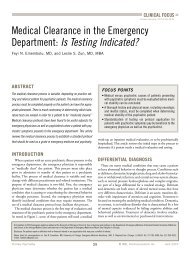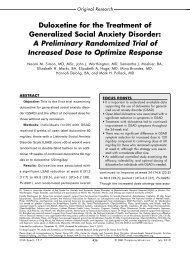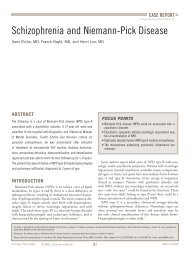The Role of the Creative Arts Therapies in the Treatment of Pediatric ...
The Role of the Creative Arts Therapies in the Treatment of Pediatric ...
The Role of the Creative Arts Therapies in the Treatment of Pediatric ...
Create successful ePaper yourself
Turn your PDF publications into a flip-book with our unique Google optimized e-Paper software.
CASE REPORT<br />
Primary Psychiatry. 2008;15(7):56-58,61-62<br />
<strong>The</strong> <strong>Role</strong> <strong>of</strong> <strong>the</strong> <strong>Creative</strong> <strong>Arts</strong> <strong>The</strong>rapies <strong>in</strong><br />
<strong>the</strong> <strong>Treatment</strong> <strong>of</strong> <strong>Pediatric</strong> Hematology and<br />
Oncology Patients<br />
Laura Letchworth Nesbitt, MT-BC, MPH, and Kim Tabatt-Haussmann, MA, ATR-BC<br />
ABSTRACT<br />
<strong>The</strong> positive effects <strong>of</strong> art and music <strong>the</strong>rapies for distraction<br />
dur<strong>in</strong>g medical visits and procedures have been well studied.<br />
<strong>The</strong>se <strong>in</strong>terventions can reduce anxiety, promote relaxation, and<br />
m<strong>in</strong>imize <strong>the</strong> perception <strong>of</strong> pa<strong>in</strong>. This article describes comb<strong>in</strong>ed<br />
art and music <strong>the</strong>rapy <strong>in</strong>terventions <strong>in</strong> <strong>the</strong> pediatric oncology/<br />
hematology environment and discusses various goals addressed<br />
dur<strong>in</strong>g out-patient visits. Patient experiences are described as<br />
<strong>the</strong>y relate to engagement <strong>in</strong> procedural accompaniments, cre-<br />
ative arts <strong>the</strong>rapy groups, <strong>in</strong>dividual <strong>the</strong>rapy sessions, and group<br />
music <strong>the</strong>rapy sessions. Interventions discussed <strong>in</strong>clude art mak-<br />
<strong>in</strong>g, active music listen<strong>in</strong>g, progressive muscle relaxation, music<br />
technology, active participation <strong>in</strong> music mak<strong>in</strong>g, songwrit<strong>in</strong>g,<br />
and lyric analysis. <strong>The</strong> patients’ social, emotional, cognitive, and<br />
physical outcomes are discussed as <strong>the</strong>y relate to treatment. In<br />
addition, <strong>the</strong> significance <strong>of</strong> <strong>the</strong> <strong>in</strong>terventions for creative arts<br />
<strong>the</strong>rapy practiced and researched is explored.<br />
INTRODUCTION<br />
For over 50 years, creative arts <strong>the</strong>rapists have been used<br />
<strong>in</strong> hospital environments to facilitate relaxation, decrease<br />
anxiety, and provide distraction. Dur<strong>in</strong>g this time, extensive<br />
research documented <strong>in</strong> medical journals has proven that<br />
Primary Psychiatry<br />
56<br />
FOCUS POINTS<br />
• <strong>The</strong> use <strong>of</strong> <strong>the</strong> creative arts <strong>the</strong>rapies <strong>in</strong> pa<strong>in</strong> management<br />
is a successful non-pharmacologic <strong>in</strong>tervention.<br />
• <strong>The</strong> presence <strong>of</strong> music and art <strong>the</strong>rapy provide a context <strong>of</strong><br />
normalization for a child <strong>in</strong> a medical environment.<br />
Ms. Nesbitt is music <strong>the</strong>rapist and Ms. Tabatt-Haussmann is art <strong>the</strong>rapist <strong>in</strong> <strong>the</strong> <strong>Pediatric</strong>s Department at New York University Langone Medical Center <strong>in</strong> New York City..<br />
Disclosure: <strong>The</strong> authors report no affiliation with or f<strong>in</strong>ancial <strong>in</strong>terest <strong>in</strong> any organization that may pose a conflict <strong>of</strong> <strong>in</strong>terest.<br />
Please direct all correspondence to: Kim Tabatt-Haussmann, MA, ATR-BC, Stephen D. Hassenfeld Children’s Center for Cancer and Blood Disorders, 160 E 32nd St, Second Floor, New York, NY 10016; Tel: 212-263-9923;<br />
Fax: 212-263-8410; E-mail: kim.tabatt@nyumc.org.<br />
© MBL Communications<br />
non-pharmacologic <strong>in</strong>terventions such as art and music <strong>the</strong>rapy<br />
have a positive impact on <strong>the</strong> patient’s quality <strong>of</strong> life. 1-5<br />
<strong>The</strong> follow<strong>in</strong>g description <strong>of</strong>fers <strong>in</strong>sight <strong>in</strong>to <strong>the</strong> <strong>in</strong>terventions<br />
provided by <strong>the</strong> art and music <strong>the</strong>rapists at an outpatient<br />
pediatric hematology/oncology cl<strong>in</strong>ic at New York<br />
University Langone Medical Center. Both <strong>the</strong>rapists worked<br />
<strong>in</strong>dividually with patients and families and exercised <strong>the</strong>ir<br />
specific skills to achieve various goals, <strong>in</strong>clud<strong>in</strong>g facilitat<strong>in</strong>g<br />
relaxation, provid<strong>in</strong>g social and peer <strong>in</strong>teraction, decreas<strong>in</strong>g<br />
anxiety, and provid<strong>in</strong>g an environment to normalize <strong>the</strong><br />
patient with<strong>in</strong> <strong>the</strong> medical environment. In <strong>the</strong> past year both<br />
discipl<strong>in</strong>es collaborated so that patients and <strong>the</strong>ir families<br />
could have more opportunities to actively participate <strong>in</strong> <strong>the</strong><br />
creative arts. <strong>The</strong> outcome was extremely positive.<br />
THE CREATIVE ARTS DEFINED<br />
Music <strong>the</strong>rapy is <strong>the</strong> art <strong>of</strong> us<strong>in</strong>g music to address a nonmusical<br />
goal. In pediatric medical sett<strong>in</strong>gs, <strong>the</strong> music <strong>the</strong>rapist<br />
particularly focuses on decreas<strong>in</strong>g a patient’s anxiety and normaliz<strong>in</strong>g<br />
<strong>the</strong> hospital or cl<strong>in</strong>ical environment through music<br />
activities. 1-5 A variety <strong>of</strong> <strong>in</strong>terventions can be used to br<strong>in</strong>g<br />
July 2008
<strong>The</strong> <strong>Role</strong> <strong>of</strong> <strong>the</strong> <strong>Creative</strong> <strong>Arts</strong> <strong>The</strong>rapies <strong>in</strong> <strong>the</strong> <strong>Treatment</strong> <strong>of</strong> <strong>Pediatric</strong> Hematology and Oncology Patients<br />
about relaxation, promote normalization, and provide distraction,<br />
<strong>in</strong>clud<strong>in</strong>g progressive muscle relaxation with music,<br />
music and imagery, hypnosis, procedural accompaniment,<br />
songwrit<strong>in</strong>g, lyric analysis, and music and movement. 1-5<br />
In a medical environment, <strong>the</strong> music <strong>the</strong>rapist works with<br />
patients, families, and medical staff <strong>in</strong> <strong>the</strong> treatment room.<br />
Dur<strong>in</strong>g various procedures, <strong>the</strong> <strong>the</strong>rapist engages <strong>the</strong> patient<br />
<strong>in</strong> live music and <strong>in</strong>troduces relaxation skills, <strong>in</strong>clud<strong>in</strong>g selfhypnosis,<br />
progressive muscle relaxation, and music-assisted<br />
imagery, to distract <strong>the</strong> patient from pa<strong>in</strong> and decrease<br />
anxiety. Music <strong>the</strong>rapy establishes a “<strong>the</strong>rapeutic environment<br />
that enhances <strong>the</strong> effects <strong>of</strong> medication and <strong>in</strong>volves patients<br />
<strong>in</strong> activities that direct attention away from <strong>the</strong> stresses <strong>of</strong><br />
illness.” 3 Once patients focus less on <strong>the</strong> stress and anxiety<br />
<strong>of</strong> an illness, <strong>the</strong>ir perception <strong>of</strong> pa<strong>in</strong> <strong>of</strong>ten abates. West 4<br />
relates that relaxation, a goal <strong>in</strong> music-<strong>the</strong>rapy <strong>in</strong>terventions,<br />
decreases muscle tension and anxiety and results <strong>in</strong> a “positive<br />
<strong>in</strong>fluence on pa<strong>in</strong> perception, nausea, and o<strong>the</strong>r symptoms.”<br />
Art <strong>the</strong>rapy, with <strong>the</strong> creative process <strong>of</strong> art mak<strong>in</strong>g, improves<br />
and enhances <strong>the</strong> physical, mental, and emotional well be<strong>in</strong>g<br />
<strong>of</strong> <strong>in</strong>dividuals <strong>of</strong> all ages. It is based on <strong>the</strong> belief that cl<strong>in</strong>ical<br />
<strong>in</strong>tervention with <strong>the</strong> act <strong>of</strong> art mak<strong>in</strong>g can heal patients and<br />
enhance <strong>the</strong>ir quality <strong>of</strong> life while help<strong>in</strong>g to reduce stress,<br />
<strong>in</strong>crease self awareness, and cope with difficult experiences. 6-11<br />
Medical art <strong>the</strong>rapy is a term applied to “<strong>the</strong> use <strong>of</strong> art expression<br />
and imagery with <strong>in</strong>dividuals who are physically ill, experienc<strong>in</strong>g<br />
trauma to <strong>the</strong> body, or who are undergo<strong>in</strong>g aggressive<br />
medical treatment such as surgery or chemo<strong>the</strong>rapy.” 7 A study <strong>of</strong><br />
<strong>the</strong> <strong>in</strong>novative use <strong>of</strong> art <strong>the</strong>rapy <strong>in</strong> reliev<strong>in</strong>g symptoms <strong>in</strong> cancer<br />
provides beg<strong>in</strong>n<strong>in</strong>g evidence for <strong>the</strong> efficacy <strong>of</strong> art <strong>the</strong>rapy <strong>in</strong><br />
reduc<strong>in</strong>g a broad spectrum <strong>of</strong> symptoms <strong>in</strong> cancer patients. 8<br />
“When art <strong>the</strong>rapy is partnered with medical treatment, children can meet <strong>the</strong><br />
challenges <strong>of</strong> serious illness. For <strong>in</strong>stance, when children create art <strong>in</strong> <strong>the</strong> medical<br />
sett<strong>in</strong>g, <strong>the</strong>y have a sense <strong>of</strong> <strong>the</strong> familiar that produces pleasurable and positive<br />
associations. <strong>The</strong> child artist ga<strong>in</strong>s control by master<strong>in</strong>g art materials and develop<strong>in</strong>g<br />
personal imagery <strong>in</strong> a situation that is <strong>of</strong>ten out <strong>of</strong> his/her control.” 9<br />
A study <strong>of</strong> art <strong>the</strong>rapy as a support for children dur<strong>in</strong>g<br />
pa<strong>in</strong>ful procedures was shown to be a useful <strong>in</strong>tervention<br />
that can prevent permanent trauma and support children and<br />
parents dur<strong>in</strong>g <strong>in</strong>trusive <strong>in</strong>terventions. 10<br />
In medical sett<strong>in</strong>gs, when children are not well enough or<br />
are unable to visit <strong>the</strong> playroom for an art <strong>the</strong>rapy group,<br />
<strong>in</strong>dividual art <strong>the</strong>rapy sessions can be provided <strong>in</strong> <strong>the</strong> treatment<br />
room so as to normalize <strong>the</strong>ir cl<strong>in</strong>ic environment and<br />
provide opportunities for socialization and expression.<br />
“One <strong>of</strong> <strong>the</strong> contributions <strong>of</strong> art <strong>the</strong>rapy to cancer treatment is <strong>the</strong> possibility <strong>of</strong><br />
help<strong>in</strong>g young people emerge from <strong>the</strong>ir illness as emotionally whole and healthy<br />
as possible. Encourag<strong>in</strong>g growth and development through art activities can help<br />
<strong>the</strong> ill child preserve many areas <strong>of</strong> normal function<strong>in</strong>g.” 12<br />
A COLLABORATIVE APPROACH: ART<br />
AND MUSIC GROUP AT THE STEPHEN<br />
D. HASSENFELD CHILDREN’S CENTER<br />
FOR CANCER AND BLOOD DISORDERS<br />
Art <strong>the</strong>rapy and music <strong>the</strong>rapy used collaboratively <strong>in</strong> a<br />
group provides <strong>the</strong> children and families with an outlet for<br />
stress management. In such an environment, <strong>the</strong>y can susta<strong>in</strong><br />
social and peer <strong>in</strong>teractions as well as normalization. In addition,<br />
<strong>the</strong>y have an opportunity to develop effective cop<strong>in</strong>g<br />
skills. Fur<strong>the</strong>rmore, art and music “<strong>the</strong>rapists can address <strong>the</strong><br />
functional skills <strong>of</strong> <strong>in</strong>dividual patients and encourage improved<br />
social skills, while provid<strong>in</strong>g <strong>the</strong> emotional outlet that is necessary<br />
for patients and families <strong>in</strong>volved” <strong>in</strong> treatment for cancer<br />
and blood disorders. 5 <strong>The</strong> art and music group takes place 1–2<br />
times a week dur<strong>in</strong>g cl<strong>in</strong>ic hours. Patients are <strong>in</strong>vited to <strong>the</strong><br />
Wellness Room, which is a large, open, non-threaten<strong>in</strong>g space<br />
with ceil<strong>in</strong>g tiles designed as night-time stars. A large sheet <strong>of</strong><br />
blank mural paper lies <strong>in</strong> <strong>the</strong> center <strong>of</strong> <strong>the</strong> room, and plush<br />
pillows and blankets are placed around <strong>the</strong> art area for <strong>the</strong><br />
patients’ comfort. Children, parents, and sibl<strong>in</strong>gs are assisted<br />
<strong>in</strong>to <strong>the</strong> room, and markers, crayons, colored pencils, foam<br />
cutouts, and a variety <strong>of</strong> o<strong>the</strong>r art mediums are available. <strong>The</strong><br />
music <strong>the</strong>rapist sitt<strong>in</strong>g on a bench near <strong>the</strong> art area beg<strong>in</strong>s<br />
<strong>the</strong> session by <strong>in</strong>troduc<strong>in</strong>g a <strong>the</strong>me, such as a trip to <strong>the</strong> zoo,<br />
life under <strong>the</strong> sea, space exploration, future dreams, or <strong>the</strong><br />
patient’s view <strong>of</strong> him- or herself. <strong>The</strong> music <strong>the</strong>rapist chooses<br />
appropriate music for <strong>the</strong> <strong>the</strong>me, and <strong>the</strong> art <strong>the</strong>rapist asks <strong>the</strong><br />
patients to close <strong>the</strong>ir eyes or focus on <strong>the</strong> song lyrics. After<br />
<strong>the</strong> music <strong>the</strong>rapist s<strong>in</strong>gs and plays <strong>the</strong> first verse <strong>of</strong> <strong>the</strong> song,<br />
<strong>the</strong> art <strong>the</strong>rapist <strong>in</strong>vites <strong>the</strong> children to draw, color, or pa<strong>in</strong>t<br />
what or how <strong>the</strong> music made <strong>the</strong>m feel. As <strong>the</strong> group progresses,<br />
different songs related to <strong>the</strong> <strong>the</strong>me are <strong>in</strong>troduced. This<br />
technique facilitates diverse imagery evident by <strong>the</strong> dist<strong>in</strong>ctive<br />
pictures that appear on <strong>the</strong> mural paper. At <strong>the</strong> conclusion <strong>of</strong><br />
<strong>the</strong> group, patients are asked to draw a f<strong>in</strong>al image reflect<strong>in</strong>g<br />
<strong>the</strong> creative arts group <strong>the</strong>me. <strong>The</strong> result is a beautiful, unique<br />
mural designed by <strong>the</strong> participants that reflects <strong>the</strong>ir self-concept<br />
and emotions.<br />
BENEFITS OF COMBINING ART AND<br />
MUSIC THERAPY<br />
Comb<strong>in</strong><strong>in</strong>g art and music <strong>the</strong>rapy at <strong>the</strong> Stephen D.<br />
Hassenfeld Children’s Center for Cancer and Blood Disorders<br />
(SDHCC) <strong>of</strong> New York University Langone Medical Center<br />
not only <strong>in</strong>creases <strong>the</strong> participants’ creativity but also distracts<br />
Primary Psychiatry © MBL Communications 57<br />
July 2008
L.L. Nesbitt, K. Tabatt-Haussmann<br />
<strong>the</strong>m from <strong>the</strong> cl<strong>in</strong>ic environment. <strong>The</strong> <strong>in</strong>terventions <strong>of</strong>fered<br />
with<strong>in</strong> <strong>the</strong> group “focus <strong>the</strong> attention away from <strong>the</strong> physical<br />
sensation <strong>of</strong> pa<strong>in</strong> to o<strong>the</strong>r aspects <strong>of</strong> <strong>the</strong> person.” 13 <strong>Pediatric</strong>oncology<br />
patients are confronted with numerous challeng<strong>in</strong>g<br />
situations, as most <strong>of</strong> <strong>the</strong>m have to undergo chemo<strong>the</strong>rapy,<br />
radiation, and surgery. Because <strong>of</strong> <strong>the</strong>ir treatment, <strong>the</strong>y are<br />
unable to experience a carefree childhood. S<strong>in</strong>ce patients<br />
<strong>of</strong>ten experience <strong>the</strong> side effects <strong>of</strong> treatment, <strong>in</strong>clud<strong>in</strong>g pa<strong>in</strong><br />
and nausea, non-pharmacologic treatments are extremely<br />
important <strong>in</strong> distract<strong>in</strong>g <strong>the</strong>m from <strong>the</strong> psychological aspects<br />
<strong>of</strong> pa<strong>in</strong>. Music and art <strong>the</strong>rapies actively <strong>in</strong>volve patients <strong>in</strong><br />
<strong>the</strong> creative process and, as a result, are able to draw attention<br />
“toward <strong>the</strong> art and music.” 9 <strong>The</strong>refore, “when an <strong>in</strong>vestment<br />
<strong>in</strong> <strong>the</strong> art or music occurs, an exchange <strong>of</strong> energy results, and<br />
energy is refocused [away] from <strong>the</strong> pa<strong>in</strong>.” 13 When music and<br />
art work toge<strong>the</strong>r to enhance <strong>the</strong> creative process, <strong>the</strong> outcome<br />
is positive because it reveals decreased anxiety, distraction<br />
from pa<strong>in</strong>, and <strong>in</strong>creased relaxation response.<br />
<strong>The</strong> music and art <strong>the</strong>rapy group also provides children<br />
and families with an opportunity to develop a positive social<br />
support group. Not only do pediatric patients miss out on<br />
classroom activities with <strong>the</strong>ir teachers and peers when <strong>the</strong>y<br />
are at a cl<strong>in</strong>ic, but <strong>the</strong>y miss out on be<strong>in</strong>g with <strong>the</strong>ir friends<br />
and participat<strong>in</strong>g <strong>in</strong> community activities as well. However,<br />
with <strong>the</strong> comb<strong>in</strong>ation <strong>of</strong> music and art <strong>in</strong> a social sett<strong>in</strong>g,<br />
children are able to socialize with peers <strong>in</strong> similar circumstances<br />
and not feel as isolated. In <strong>the</strong> creative arts group,<br />
patients have <strong>the</strong> opportunity to feel normal, make friends,<br />
work on art toge<strong>the</strong>r, play and s<strong>in</strong>g, learn, and, most importantly,<br />
have fun <strong>in</strong> a safe creative environment.<br />
THE MUSIC AND ART GROUP DEFINED<br />
Patients visit <strong>the</strong> outpatient cl<strong>in</strong>ic with parents/guardians,<br />
sibl<strong>in</strong>gs, grandparents, o<strong>the</strong>r relatives and friends. Because<br />
cancer affects <strong>the</strong> child’s family and network <strong>of</strong> support, <strong>the</strong><br />
<strong>the</strong>rapists encourage and <strong>in</strong>vite caregivers to actively participate<br />
<strong>in</strong> <strong>the</strong> creative arts group. Focus<strong>in</strong>g on family-centered<br />
care, <strong>the</strong> group aims to reduce anxiety and educate participants<br />
on effective cop<strong>in</strong>g skills and relaxation tools to <strong>in</strong>crease<br />
understand<strong>in</strong>g and support. For each caregiver present, <strong>the</strong><br />
group work re<strong>in</strong>forces <strong>the</strong> idea that <strong>the</strong> child’s creativity,<br />
imag<strong>in</strong>ation, development, and spirit are ma<strong>in</strong>ta<strong>in</strong>ed and<br />
validated throughout <strong>the</strong>ir treatment.<br />
<strong>The</strong> Music and Art Group is a 45-m<strong>in</strong>ute session that takes<br />
place <strong>in</strong> a controlled and comfortable space with m<strong>in</strong>imal<br />
design and distraction. <strong>The</strong> Wellness Room is separate from<br />
<strong>the</strong> playroom and wait<strong>in</strong>g room, which helps participants<br />
focus on <strong>the</strong> music and art. Mural paper is placed <strong>in</strong> <strong>the</strong><br />
middle <strong>of</strong> <strong>the</strong> floor as well as markers, crayons, foam shapes,<br />
and colored pencils. Pillows surround <strong>the</strong> paper, pos<strong>in</strong>g as<br />
comfortable seats for <strong>the</strong> participants.<br />
<strong>The</strong> <strong>the</strong>rapists decide on a <strong>the</strong>me for <strong>the</strong> group (eg, animals,<br />
beach activities, ra<strong>in</strong>bows, water and outer space) that<br />
has vivid imagery related to it. After <strong>the</strong> music <strong>the</strong>rapist collects<br />
appropriate song material, both <strong>the</strong>rapists ga<strong>the</strong>r <strong>the</strong><br />
patients to beg<strong>in</strong> <strong>the</strong> group. <strong>The</strong> art <strong>the</strong>rapist provides various<br />
materials and co-facilitates guid<strong>in</strong>g participants <strong>in</strong> imagery<br />
before <strong>the</strong> art creat<strong>in</strong>g beg<strong>in</strong>s.<br />
<strong>The</strong> group is encouraged to sit comfortably and participate<br />
<strong>in</strong> active listen<strong>in</strong>g, a music <strong>the</strong>rapy <strong>in</strong>tervention. As <strong>the</strong><br />
music <strong>the</strong>rapist performs <strong>the</strong> song, participants are asked to<br />
listen to <strong>the</strong> music, close <strong>the</strong>ir eyes, and imag<strong>in</strong>e <strong>the</strong> pictures<br />
that come to m<strong>in</strong>d from <strong>the</strong> song lyrics. Songs performed <strong>in</strong><br />
<strong>the</strong> past to elicit vivid imagery <strong>in</strong>clude “Go<strong>in</strong>g to <strong>the</strong> Zoo,”<br />
“Under <strong>the</strong> Sea,” “Rocketship Run,” and “Puff <strong>the</strong> Magic<br />
Dragon” (Figures 1–4).<br />
While <strong>the</strong> music <strong>the</strong>rapist cont<strong>in</strong>ues to perform a variety <strong>of</strong><br />
<strong>the</strong>me-related songs, <strong>the</strong> patients and families, who <strong>of</strong>ten s<strong>in</strong>g<br />
along, are encouraged by <strong>the</strong> art <strong>the</strong>rapist to beg<strong>in</strong> draw<strong>in</strong>g<br />
images on <strong>the</strong> mural paper. While <strong>the</strong>y are listen<strong>in</strong>g and s<strong>in</strong>g<strong>in</strong>g,<br />
<strong>the</strong> art <strong>the</strong>rapist helps <strong>the</strong> participants th<strong>in</strong>k about <strong>the</strong><br />
song and images that come to m<strong>in</strong>d. Work<strong>in</strong>g on one piece<br />
<strong>of</strong> mural paper, which is a metaphor for <strong>the</strong> group work<strong>in</strong>g<br />
toge<strong>the</strong>r, encourages <strong>the</strong>rapeutic play through image mak<strong>in</strong>g.<br />
One <strong>in</strong>itial image <strong>in</strong>spires ano<strong>the</strong>r and gradually transforms<br />
<strong>the</strong> mural <strong>in</strong>to storytell<strong>in</strong>g through music and art.<br />
While <strong>the</strong> group is creat<strong>in</strong>g images and listen<strong>in</strong>g to <strong>the</strong><br />
music, <strong>in</strong>dividuals <strong>of</strong>ten talk about <strong>the</strong>ir draw<strong>in</strong>gs, and<br />
o<strong>the</strong>rs s<strong>in</strong>g and dance to <strong>the</strong> music. As <strong>the</strong>y observe <strong>the</strong><br />
FIGURE 1<br />
GOING TO THE ZOO<br />
Nesbitt LL, Tabatt-Haussmann K. Primary Psychiatry. Psychiatry Vol 15, No 7. 2008.<br />
(cont. on pg. 61)<br />
Primary Psychiatry © MBL Communications 58<br />
July 2008
(cont. from pg. 58)<br />
<strong>The</strong> <strong>Role</strong> <strong>of</strong> <strong>the</strong> <strong>Creative</strong> <strong>Arts</strong> <strong>The</strong>rapies <strong>in</strong> <strong>the</strong> <strong>Treatment</strong> <strong>of</strong> <strong>Pediatric</strong> Hematology and Oncology Patients<br />
dynamics <strong>of</strong> <strong>the</strong> group, <strong>the</strong> leaders re<strong>in</strong>force <strong>the</strong> idea that<br />
<strong>the</strong>re is no right or wrong method.<br />
As <strong>the</strong> session ends, <strong>the</strong> <strong>the</strong>rapists review <strong>the</strong> journey<br />
and discuss <strong>the</strong> images created on <strong>the</strong> mural paper, nam<strong>in</strong>g<br />
<strong>the</strong> particular songs that guided <strong>the</strong> patients’ imag<strong>in</strong>ation.<br />
Participants are encouraged to first discuss <strong>the</strong> images and<br />
music <strong>the</strong>n choose a title for <strong>the</strong> group mural. All participants<br />
sign <strong>the</strong>ir names on <strong>the</strong> artwork, an act which <strong>in</strong>creases <strong>the</strong>ir<br />
self-esteem, produces self-actualization, and provides positive<br />
re<strong>in</strong>forcement for <strong>the</strong>ir creative abilities. <strong>The</strong> group mural<br />
is <strong>the</strong>n displayed <strong>in</strong> <strong>the</strong> playroom for <strong>the</strong> SDHCC’s staff,<br />
patients, and families. <strong>The</strong> participants take pride <strong>in</strong> <strong>the</strong>ir f<strong>in</strong>ished<br />
product, and as a result, more patients are encouraged<br />
to participate <strong>in</strong> <strong>the</strong> next creative arts group.<br />
FIGURE 2<br />
UNDER THE SEA<br />
Nesbitt LL, Tabatt-Haussmann K. Primary Psychiatry. Psychiatry Vol 15, No 7. 2008.<br />
FIGURE 3<br />
ROCKETSHIP RUN<br />
Nesbitt LL, Tabatt-Haussmann K. Primary Psychiatry. Psychiatry Vol 15, No 7. 2008.<br />
CONCLUSION<br />
Art and music <strong>the</strong>rapy used toge<strong>the</strong>r is extremely effective,<br />
especially with pediatric oncology/hematology patients,<br />
because it helps <strong>the</strong>m address <strong>the</strong> physical issues <strong>of</strong> pa<strong>in</strong> as<br />
well as <strong>the</strong> emotional issues <strong>in</strong> a non-pharmacologic and<br />
non-threaten<strong>in</strong>g way. <strong>The</strong> dynamics <strong>of</strong> sound and its impact<br />
on physical symptoms should be understood. For example,<br />
when sound travels through <strong>the</strong> “reticular activat<strong>in</strong>g system<br />
<strong>of</strong> <strong>the</strong> bra<strong>in</strong> stem [and] coord<strong>in</strong>ates sensory <strong>in</strong>put, it alerts <strong>the</strong><br />
cortex to <strong>in</strong>com<strong>in</strong>g <strong>in</strong>formation.” 1 <strong>The</strong>refore, when <strong>the</strong> bra<strong>in</strong><br />
is activated, <strong>the</strong> sound “competes for cognitive awareness”<br />
and causes pa<strong>in</strong> and nausea to be ignored. 1<br />
Music <strong>the</strong>rapy and its effect on anxiety and relaxation<br />
have been well documented <strong>in</strong> research and case studies<br />
over <strong>the</strong> years. 2,5,13,14 Hanser 2 reports decreased scores on<br />
<strong>the</strong> A-State Anxiety Inventory <strong>in</strong> <strong>the</strong> presence <strong>of</strong> <strong>in</strong>duced<br />
anxiety when music is play<strong>in</strong>g, whereas Trauger-Querry<br />
relates that music has a way to “engage, activate and alter<br />
affective, cognitive and sensory processes through distraction,<br />
alteration <strong>of</strong> mood, improved sense <strong>of</strong> control, <strong>the</strong> use<br />
<strong>of</strong> prior skills and relaxation.” 2,13 Exercis<strong>in</strong>g <strong>the</strong>se skills and<br />
establish<strong>in</strong>g a normal environment where pediatric patients<br />
can play and have fun without th<strong>in</strong>k<strong>in</strong>g about <strong>the</strong>ir illness<br />
is <strong>of</strong> paramount importance.<br />
Imagery, facilitated by <strong>the</strong> art and music <strong>the</strong>rapist, is<br />
ano<strong>the</strong>r layer that can be added to musical stimuli <strong>in</strong> divert<strong>in</strong>g<br />
pa<strong>in</strong> perception. A study <strong>in</strong> which progressive muscle<br />
relaxation and guided imagery was used to delay or prevent<br />
“chemo<strong>the</strong>rapy-<strong>in</strong>duced nausea and vomit<strong>in</strong>g” with HIV<br />
patients was conducted, and <strong>the</strong> f<strong>in</strong>d<strong>in</strong>gs demonstrated that<br />
24 hours after chemo<strong>the</strong>rapy, <strong>the</strong> experimental group, hav-<br />
FIGURE 4<br />
PUFF THE MAGIC DRAGON<br />
Nesbitt LL, Tabatt-Haussmann K. Primary Psychiatry. Psychiatry Vol 15, No 7. 2008.<br />
Primary Psychiatry © MBL Communications 61<br />
July 2008
L.L. Nesbitt, K. Tabatt-Haussmann<br />
<strong>in</strong>g used guided imagery techniques, had decreased levels <strong>of</strong><br />
nausea for up to 60 hours after treatment. 15 As patients focus<br />
positively and reach new levels <strong>of</strong> awareness through music<br />
and art, <strong>the</strong>ir tension and anxiety decrease. PP<br />
REFERENCES<br />
1. Skaggs R. <strong>The</strong> Bonny Method <strong>of</strong> Guided Imagery and music <strong>in</strong> <strong>the</strong> treatment <strong>of</strong> term<strong>in</strong>al illness:<br />
a private practice sett<strong>in</strong>g. Music <strong>The</strong>rapy Perspectives. 1997;15(1):39-44.<br />
2. Hanser SB. Music <strong>the</strong>rapy and stress reduction research. J Music <strong>The</strong>r. <strong>The</strong>r 1985;22:193-206.<br />
3. Blom RC, Wylie ME. Guided imagery and music with hospice patients. Music <strong>The</strong>rapy<br />
Perspectives. 1986;3:25-28.<br />
4. West TM. Psychological issues <strong>in</strong> hospice music <strong>the</strong>rapy. Music <strong>The</strong>rapy Perspectives.<br />
1994;12(2):117-124.<br />
5. Barker VL, Brunk B. <strong>The</strong> role <strong>of</strong> a creative arts group <strong>in</strong> <strong>the</strong> treatment <strong>of</strong> clients with traumatic<br />
bra<strong>in</strong> <strong>in</strong>jury. Music <strong>The</strong>rapy Perspectives. 1991;9:26-31.<br />
6. Malchiodi C. Medical art <strong>the</strong>rapy with children. London, UK: Jessica K<strong>in</strong>gsley Publishers; 1999.<br />
7. Malchiodi C. Introduction to special issue: art and medic<strong>in</strong>e. Art <strong>The</strong>r J Am Art <strong>The</strong>r Assoc.<br />
1993;10(2):66-69.<br />
8. Na<strong>in</strong>is N, Paice J, Ratner J, Wirth J, Lai J, Shott S. Reliev<strong>in</strong>g symptoms <strong>in</strong> cancer: <strong>in</strong>novative<br />
use <strong>of</strong> art <strong>the</strong>rapy. J Pa<strong>in</strong> Symptoms Manage. Manag 2006;31:162-169.<br />
9. Council T. Art <strong>The</strong>rapy with pediatric cancer patients: help<strong>in</strong>g normal children cope with<br />
abnormal circumstances. Art <strong>The</strong>r J Am Art <strong>The</strong>r Assoc. 1993;10(2):78-87.<br />
10. Favara-Scacco C, Smirne G, Schilirò G, Di Cataldo A. Art <strong>the</strong>rapy as support for children with<br />
leukemia dur<strong>in</strong>g pa<strong>in</strong>ful procedures. Med Pediatr Oncol. Oncol 2001;36(4):474-480.<br />
11. Walsh SM, Mart<strong>in</strong> SC, Schmidt LA. Test<strong>in</strong>g <strong>the</strong> efficacy <strong>of</strong> a creative arts <strong>in</strong>tervention with<br />
family caregivers <strong>of</strong> patients with cancer. J Nurs Scolarsh. 2004;36(3):214-219.<br />
12. Council T. Art <strong>The</strong>rapy with pediatric cancer patients. In: Malchiodi C, ed. Medical Art <strong>The</strong>rapy<br />
with Children. 1st ed. New York, NY: Jessica K<strong>in</strong>gsley Publishers; 1999:91.<br />
13. Trauger-Querry B, Haghighi KR. Balanc<strong>in</strong>g <strong>the</strong> focus: art and music <strong>the</strong>rapy for pa<strong>in</strong> control<br />
and symptom management <strong>in</strong> hospice care. Hospice J. J 1999;14(1):25-38.<br />
14. Logan T, Roberts A. <strong>The</strong> effects <strong>of</strong> different types <strong>of</strong> relaxation music on tension level. J Music<br />
<strong>The</strong>r. <strong>The</strong>r 1984;21:177-183.<br />
15. Capeli B, Anastasi JK. A symptom review: nausea and vomit<strong>in</strong>g <strong>in</strong> HIV. J Assoc Nurses AIDS<br />
Care. 1998;9(6):47-56.<br />
Primary Psychiatry © MBL Communications 62<br />
July 2008


